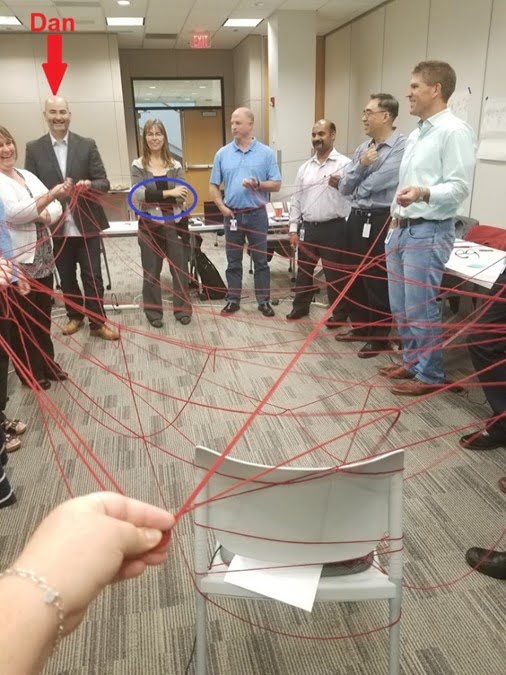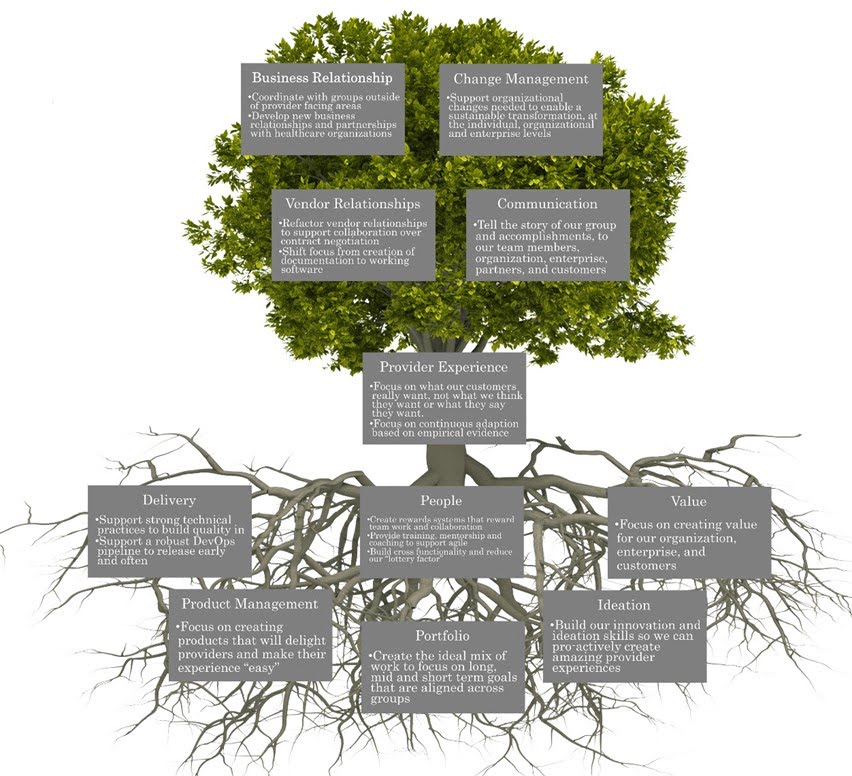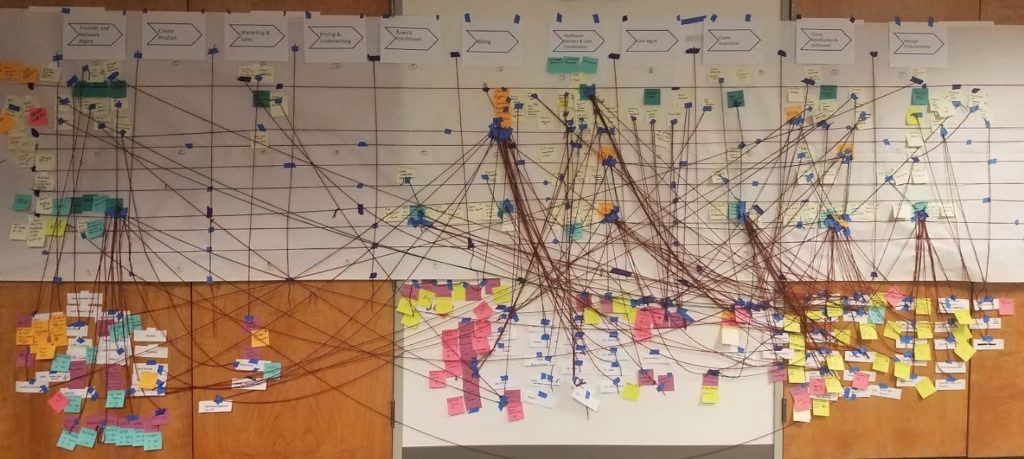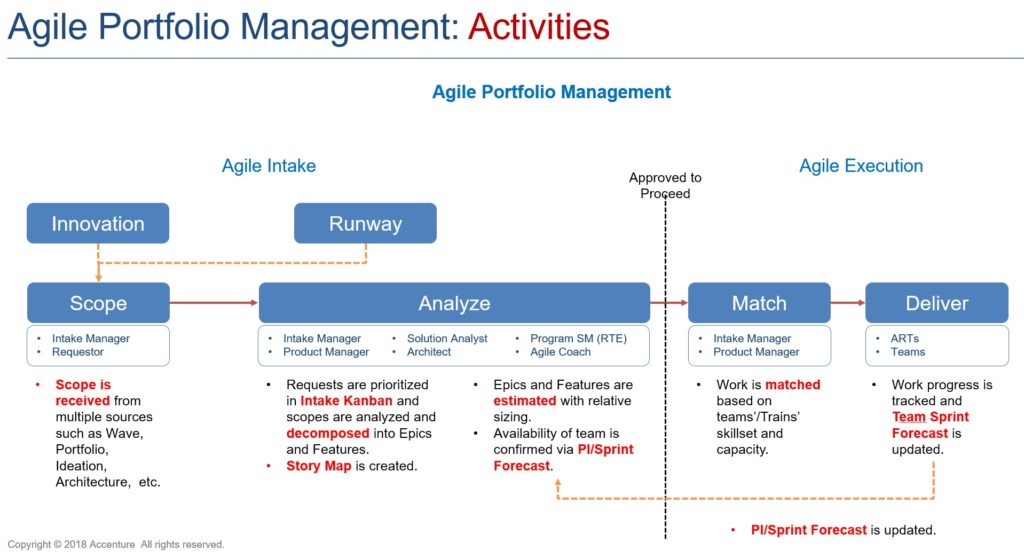We built a new group that cut across traditional functional towers, divisions and specialties to launch a new truly cross functional virtual organization with one focus, removing barriers for doctors and make their experience with Anthem easy.
1. INTRODUCTION
The cost of healthcare administration is crushing Americans. According to National Institute of Health, it was projected to be $315 billion in 2018 1. As a healthcare payer, we recognized an opportunity to improve the lives of thousands of healthcare providers and patients by streamlining the provider experience.
The provider organization had begun with several pre-existing Agile teams. The digital organization decided to implement the Scaled Agile Framework about a year before. The coaching office brought in a coach, Emilia Breton, who had successfully launched Agile Release Trains for the legacy mainframe group, to prepare and launch a single Agile Release Train. They believed that it would help release software faster, making it easier for doctors and administrators to work with the organization. As it turns out, it would take far more than simply launching an Agile Release Train to transform the relationships between providers and health insurers and to get to real business agility outcomes.
In this paper, Dan Scalfaro – Director of Digital IT at Anthem, a national healthcare payer – and Emilia Breton – Agile coach at Accenture|SolutionsIQ – will share their experience working together over the course of six months to establish a powerful communication platform that would break down barriers that had existed between business and IT organizations at Anthem for decades. As a result of this partnership, the organization has a unique opportunity to simplify antiquated processes in healthcare to the benefit of all – leading to happier, less stressed healthcare providers.
Often, coaches are brought into a group to implement a framework, but the results promised by ‘Agile Evangelists’ cannot be realized. In order to realize the true power of agility, we needed to start with transforming leadership and bringing people from across different business and IT silos and groups together. We started out with instructions to launch a train and instead created a new diverse and powerful group that could change the face of healthcare now and in the future.
Over the course of 6 months, we built this new group, which would cut across traditional functional towers, divisions and specialties to launch a truly cross-functional virtual organization with one focus: removing barriers for doctors to make their experience with Anthem easy. This work would be tremendously important in addressing barriers for providers to work with the Anthem platform such as joining and having claims paid.
2. BACKGROUND
In 2016 I, Dan, launched the first Agile teams in the digital organization. Initially, the teams were energized around the improvements they saw in faster delivery and quality. However, as time went on, I noticed that I was not seeing a positive change in real business values, which had been an important motivator for launching the teams in the first place. Later, the enterprise as a whole embarked on a journey to implement the Scaled Agile Framework. During this time, I, Dan, worked with several coaches to help my teams become more effective in Agile practices.
In June 2017 I, Emilia, joined the coaching team at Anthem to help the with the mainframe claims group with their Agile transformation. After a very successful Agile pilot including developing several agile teams and a very successful train launch in May 2018 the agile coaching office asked me to move over to help the provider group. I met with their current coach who was days away from leaving the organization, he passed me a couple of pictures from a workshop where they had identified 5 teams that should form a single Agile Release Train. The coaching office told me this would be a “quick and easy” train launch.
In June of 2018, I, Emilia, joined Dan’s Digital IT group ready for a simple, train everyone and launch the train SAFe implementation. As Dan and I began talking and working on his vision for the future of the Provider group, we, discovered that making an efficient team-of-teams was far more complex than reorganizing a handful of independent Scrum teams into a SAFe Program.
Amongst the obstacles we encountered was that business priorities were unclear and subject matter experts were spread across a vast siloed organization. It quickly became apparent that to achieve desired business outcomes we would need to transform not only the way teams were working together, but also the basic fabric of the organization. We concentrated on establishing a formal “Executive Action Team” with business and IT leaders from across the organization to collaborate on solutions that would address real problems as well as achieve the business goals of cost savings and improved services for health care providers.
3. OUR STORY
At Anthem in 2016, Agile transformation was thought to be too dramatic of a change. I, Dan, wanted to temper the backlash of adjustments in the ways my teams and I worked. In my role as a technology director, I have the responsibility of redefining my role and assembling development teams that build digital assets for providers. I came to the realization that my job is ultimately focused on making the interaction between Anthem, the payer, and our healthcare professionals more efficient.
In the summer of 2016, several IT departments, including mine, started investigating and employing Agile development practices. I started by focusing on building a pilot Scrum team that iterated on their work and used Agile nomenclature but was not focused on broader process and cultural change. This team was built by coalescing the most open and adaptive team members in my organization that I felt had the ability to embrace change. Although I initially struggled with some of the basic Agile concepts, continuing to read and research helped reveal the power of Agility. I am comfortable with change and growth and knew that to someone who was not as open-minded and flexible, Agile would prove too radical and overwhelming. This pilot team would then become the exemplars of the transformation, and the ambassadors for the massive strategic changes on the horizon.
I slowly started to introduce Agile to my business partners with some success. I knew that having them onboard would be critical to transform the larger team. Since they, unfortunately, did not have any background in agility, they looked at it only as an “IT thing” that gave them some control over the IT work and timelines.
I had several coaches assigned to my department before Emilia. I was struggling to grow my group’s Agile maturity and couldn’t find the right partner to take on my ambitious and radical ideas for transformation. Even after Emilia and I’s first conversation, I didn’t get the sense that transforming my department would be successful – I was wrong. The passion Emilia and I shared towards the daunting task of transforming my department quickly turned into a well-organized, actionable plan that would transform not only my department but my business and IT partners as well.
3.1 The Birth of Business Agility
When I, Emilia, joined the group at the beginning of June 2018, I started by performing an in-depth discovery to establish a baseline and identify what the challenges and goals for scaling the group were. In my first conversation with Dan I realized that we were about to take on something far larger than launching a single Agile Release Train. Dan had a number of ambitious goals to revolutionize the way Anthem addressed the needs of healthcare providers. From that first conversation I knew that this would be the most difficult and impactful journey I had embarked on as a consultant. However, with Dan’s passion and openness to change I knew we were set up for success.
Together Dan and I discovered the traditional business and IT silos and the players from each, including people from across the traditional organization including representatives from business, provider relations, contracting, Digital IT, Electronic Data Interchange IT, Mainframe IT, SOA, and support.
 Figure 1. Executive Action Team the Missing String
Figure 1. Executive Action Team the Missing String
Our first step toward Business Agility was to form an Executive Action Team (EAT) including members from seven business groups, four IT groups and three vendors. We wanted to quickly visualize the relationships between the different participants so one of the first exercises that the EAT did together was a ‘string game’ (Figure 1). Starting with Dan the leader of the group each person passed the string to the person they talked to the most. When someone got the string, they passed it to the next person they had talked to the most.
From this very simple exercise the new Executive Action Team was able to gain some deep insights:
- A few people, including Dan, were actually bottlenecks in the value stream
- People who worked daily with providers (the customers of the group) was almost never a part of planning or development conversations
- Some of the integral team members who were rarely seen in person (represented by the phone on the chair) were not fully engaged.
These insights helped them to create a set of working agreements that laid the foundation for how the group would work and learn together.
Next the EAT worked on cultivating the deep bonds that would allow them to transcend their traditional groups. An early step in this process was facilitating the creation and sharing of their journey lines. This allowed the team not only to start building psychological safety but also revealed several hidden skills that helped this team of leaders to create transformation momentum.
They learned about Agile leadership and worked together to define the what their capabilities and maturity models were for Agile transformation and execution. The capabilities they identified as critical were Provider Experience, Product, People, Value, Portfolio, Ideation, Vendor Relationships, Communications, Delivery, Business Relationships, and Change.
The EAT used a version of the innovation game “Pruning the Product Tree” (Figure 2) to create a backlog of items focused on improving the maturity of business capabilities to allow the Agile environment to thrive. For each capability the members of the EAT team volunteered to act as stewards, which provided leadership in fostering the changes required. These changes included:
- Changing the way people were trained and rewarded
- Creating a new combined portfolio intake process for business and IT
- Changing vendor relationships to foster partnership instead of tossing work “over the wall”
This work continues, and the stewards are focused on relentless and continuous improvement.
 Figure 2. Executive Action Team Tree
Figure 2. Executive Action Team Tree
3.2 Building the eco-system for Agile to thrive
One of the first focus areas that the EAT identified was Provider Experience, the ‘trunk’ of the capability ‘tree’. A gap that the group identified was the need for a shared understanding of ‘Why’ they were doing the work that they were doing. The EAT came together and used Simon Sinek’s Golden Circle2 to come to a shared understanding of their ‘Why’ and then socialize this with the development teams, product owners, business partners, and stakeholders.
As the EAT began to communicate with the rest of Anthem about the transformation of the provider area and that the creation of this new virtual organization spanned across many traditional groups. They found that they needed to define a new cultural identity for the new organization. The EAT team enlisted leaders to join them to create a branding workshop for articulating the personality of this new group. From that set of workshops, the Advanced Provider Experience (APEX) group got its name. The communications became focused on telling stories that reflected the values and personality of the group. This provided a platform for gaining support from the organization and enrolling more teams into this new work paradigm.
As the Product and Portfolio capabilities started to emerge it became apparent that the group did not have a strong definition of what their products were, or a good understanding how value flowed through the organization. To achieve clarity, we held a Product Definition and Value Stream Mapping workshop based on the Scaled Agile Framework (Figure 3). This info formulated a plan to launch five Agile Release Trains aligned to their product value streams. Each train included members and teams from multiple business groups and IT groups. This allowed them to focus on creating desired outcomes for doctors and other medical providers while minimizing handoffs, dependencies and delays.
 Figure 3. Value Stream Mapping and Product Definition
Figure 3. Value Stream Mapping and Product Definition
After many meetings among the Portfolio stewards, Emilia, Dan, and a variety of stakeholders, the EAT developed an Agile-Lean portfolio management process (Figure 4) to ensure business and IT were identifying and engaging with highest value work together as a group. Previously, priority was determined using the “whoever yelled the loudest” method; business and IT each had separate backlogs, intake processes and priorities. In the new portfolio structure priorities were refocused on creating the most value for providers in the shortest amount of time. Some existing projects were canceled or shelved to unburden teams and allow them to focus on completing highest priority product work as well as reduce multitasking and split commitments.
 Figure 4. Portfolio Process
Figure 4. Portfolio Process
Priority projects were morphed into Agile Release Trains and the group started with creating big room planning meetings where all team members, including waterfall teams, would attend. In these meetings the first step was to shorten the time boxes, which was a revelation to many of the groups who joined us. These groups, especially the mainframe groups, were used to working in isolation, taking in specs and delivering completed work six to twelve months later with little or no interaction.
The first big planning session was a culture shock. By the end of the two-day planning those groups were able to commit to providing small slices of value in twelve-week increments with collaboration sessions twice a week. They were also able to identify and plan for a number of dependencies and risks. As we proceeded to the next increment, those teams were able to deliver in four-week chunks. Once they were successful with breaking down work into smaller, leaner chunks, we began to gain interest and trust. Only then were we able to start introducing the Agile and SAFe values, principles, and practices as written without it feeling to be too radical or overwhelming. By the third increment we were in a position for the teams to break their work down into two-week iterations, create real PI objectives, and have a reliable PI plan.
3.3 Results
The Advanced Provider Experience group’s work is enabling the organization to make a bigger impact in healthcare by reducing the overhead associated with claim processing and payments. Removing barriers between the silos allowed us to create solutions that were targeted to drastically improve processes like these, while being flexible and adaptable. One of their first big wins had been to reduce the time and human intervention required for new providers to join the organization, which shrank from months to days.
4. WHAT WE LEARNED
Over the six months that we worked together to bring business agility into to the provider organization we learned a number of lessons, some were easy others were more painful.
One of the first lessons we learned was to start with ‘Why’. Once the driving factors from the business and IT sides are understood the path becomes much clearer and crossing the boundaries for true cultural change requires a smaller leap. We not only had to discover our ‘Why’ we had to share it with everyone who was willing to listen, and keep it at the top of all of our minds throughout the transformation.
One of the more painful lessons we learned was never underestimate the power of entrenched power structures. Bringing multiple business and IT units together can be uncharted territory as it threatens existing fiefdoms. Be prepared to address those who feel threatened and bring them in as allies. We ran into this again and again as we added teams and groups. However, the bright side is those early allies you recruit become your evangelists for the groups that come after.
Next, Identify the people you need to make a lasting change happen. It takes a ‘village’, and many people with knowledge and skills you need may not be inside traditional business or IT units. In fact, more than likely they are not. Some of our best ideas and support came from unexpected places, never be afraid to ask around until you find the people with the skills and knowledge you need.
Deep insights can be gained with a length of string. Visualizing the communication lines and relationships between groups and individuals will help you identify gaps and bottlenecks. In our case it was a piece of string in yours it may be another metaphor, however the power of using metaphor, games, and visualizations to reveal the system to its self holds enormous power.
Finally changing the way an organization works requires far more than a single coach for a brief amount of time. If you want to create sustainable change find allies in business and IT, give them the knowledge and freedom so they are empowered to carry the change into their groups and departments, make sure you have the coaching support you need, and let them do the work!
5. ACKNOWLEDGEMENTS
Thank you to the entire Advanced Provider Experience group at Anthem especially Spencer Wells, Holly Henry and Denise Pike. Thank you to the amazing Scrum Masters from Cumberland especially Mike Griesbaum who serves as the Scrum Master of the EAT and helped to make the magic happen. Special thanks and acknowledgement to Haylee Collins, Geoff Lynch, Claire Wybro, and the entire DMI team for hosting, coordinating and driving many of the organizational effectiveness conversations that made up the capabilities on the EAT Tree. Thank you to David Kollm for his deep SAFe knowledge and the Accenture|SolutionsIQ coaching team for all of their support throughout the process – especially for moral support when things got tough, we needed a second facilitator or just another coaches’ ear. Thank you, Ryan Keawekane, for all of your amazing copy-editing help. Last, but certainly not least, thank you to Cherifa Mansoura, our shepherd, who pointed us in the right direction and held us accountable – we could not have done it without you.
REFERENCES
- Institute of Medicine (US) Roundtable on Evidence-Based Medicine; Yong PL, Saunders RS, Olsen LA, editors. The Healthcare Imperative: Lowering Costs and Improving Outcomes: Workshop Series Summary. Washington (DC): National Academies Press (US); 2010. 4, Excess Administrative Costs. Available from: https://www.ncbi.nlm.nih.gov/books/NBK53942/
- Sinek, Simon, The Golden Circle Presentation, https://simonsinek.com/commit/the-golden-circle



